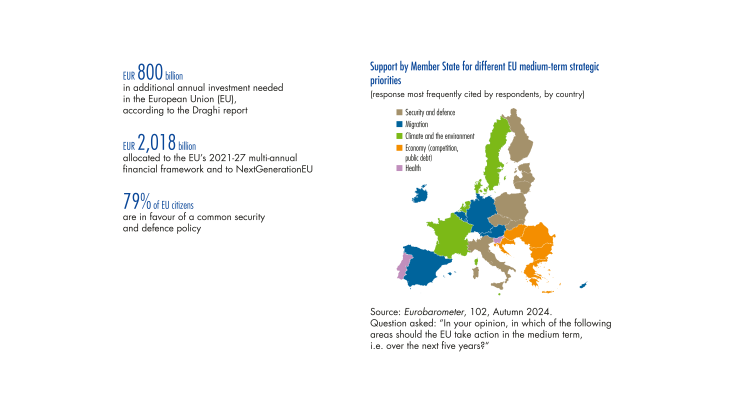1 European public goods need European governance
In order to strengthen the European Union’s (EU) long term competitiveness and resilience, the Draghi report (2024) recommends redirecting the EU budget towards the financing of European public goods (see Box 1). Due to cross border externalities, the production of these goods would benefit from being coordinated at EU rather than national level. From a central bank perspective, increased funding for European public goods would be beneficial: it would help make the euro area more competitive and resilient, which in turn would underpin medium term price stability.
Opting for European governance of public goods would help in finding the balance between the advantages of centralisation and the disadvantages related to diverse preferences. In the EU, public goods can be managed at local, national or European level. To ascertain whether or not there is “European added value” to managing a public good at EU rather than national level, three criteria need to be analysed (Alesina et al., 2005; Claeys and Steinbach, 2024).
- The existence of economies of scale at European level: this generally relates to the presence of high fixed costs, with an average production cost that decreases as quantities increase. The defence sector is a case in point: it features numerous fixed costs related to the development of technologies and equipment (Scazzieri and Tordoir, 2024; Steinbach and Wolff, 2024). A European governmental body could therefore provide the public good at lower unit costs than a plethora of national producers.
- The internalisation of cross border externalities: if decisions to provide public goods are made at individual country level, the positive externalities generated by the supplier country for others may lead to free riding, with the risk of underproduction of the public good at European level.
- A certain uniformity of preferences at European level for the provision of public goods: citizens’ preferences vary according to their socio economic and cultural circumstances, which influence their priorities with regard to public goods. Highly diverse preferences within the EU make it more difficult to justify federal management as this would not adequately respond to citizens’ local preferences. Conversely, relatively homogeneous preferences at European level would argue in favour of federal management. …
